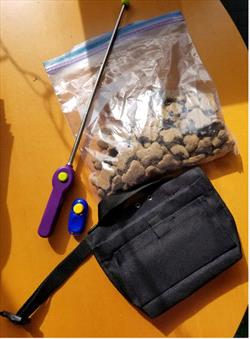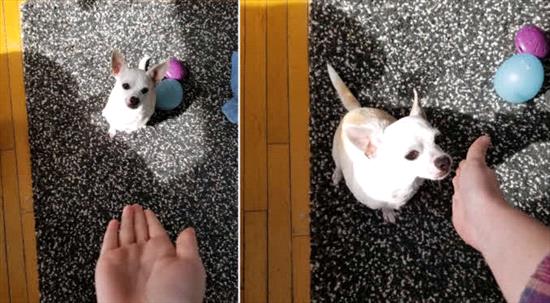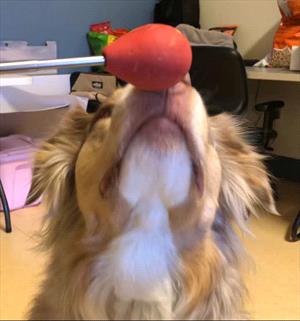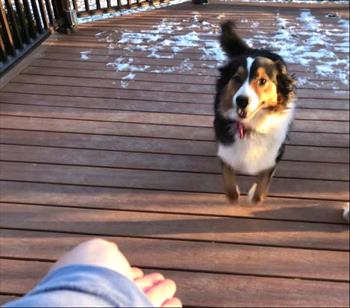Pat Koven, LVT, KPA-CTP; Sandra Robins, BS, CVT, VTS (anesthesia & analgesia), CPDT-KSA, KPA-CTP; Katharine Schwarz, RVT, KPA-CTP
What is targeting?
Targeting is teaching your dog to touch a part of their body such as a paw, shoulder, hip, or nose to a specific object.
The most common use is asking the dog to touch their nose to a person’s hand. Here we outline nose targeting.
Why use targeting?
Targeting is a fun and easy behavior to teach and is a basic skill or building block that can be used as part of teaching many different behaviors such as:
- Moving your dog from one place to another, such as on or off furniture, across a room, or over a threshold to another room.
- Entering or exiting a carrier, crate, or car.
- Directing your dog on and off the scale or examination table at your veterinarian’s office.
- An alternative cue for your dog to come when called.
- Opening and closing doors, drawers, and even the refrigerator.
Targeting is also a behavior that can be used to:
- Iimprove confidence levels.
- Greet new people.
- Get your dog’s attention away from something scary.
- Teach new behaviors.
Tools needed:
- A clicker (or a mouth noise).
- Training treats or kibble.
- Your hand or target stick.
Training supplies

Training supplies.
Photo courtesy of Katharine Schwarz, RVT, KPA-CTP.
What else can be used for targeting?
- Paint stick
- Spatula
- Cell phone (since nearly everyone has one at all times)
- A spot on the wall or door
- Sticky Notes
- Any object you choose
Getting started with targeting:
- Facing your dog, hold your target hand, palm open and fingers pointed to the ground, a couple inches away from your dog’s nose. Be sure not to move your hand into your dog’s face.
- When your dog sniffs, licks, or otherwise touches your target hand, click your clicker, remove your target hand, and provide a treat from your other hand.
- Repeat steps one and two several times.
- With each practice session, move your hand into a slightly different position, and gradually further away from your dog’s face.
- When your dog is reliably touching your hand with their nose, you are ready to add a cue. Say touch just prior to your dog touching your target hand, then click and treat.
Teaching a nose touch to a hand

Teaching a nose touch to a hand.
Photo courtesy of Katharine Schwarz, RVT, KPA-CTP.
Targeting an object
It is helpful to teach dogs to target an object other than your hand if there is a concern for safety or at times when your hand is less practical such as when entering a crate. Follow the steps above using a target stick or other object instead of your hand.
Touching the target stick

Touching the target stick.
Photo courtesy of Pat Koven, LVT, KPA-CTP.
Adding in movement:
When your dog is reliably touching your hand or the object with his nose on cue, you are ready to add movement to the touch behavior.
Method 1: Person standing still with the target moving
Hold out the target and cue touch. When your dog approaches the object, move it slightly further away. Click and treat the dog for following and touching the target. Gradually increase the distance between the dog and the target.
Method 2: Person walking with target
While holding out the target, start slowly walking around the room and cue touch. When your dog follows and touches the target, click and treat. Try walking backwards and cue touch while holding out the target. Alternate the object from one hand to the other and increase your speed as your dog gets more excited. Remember to click and treat for every nose touch.
Adding in distractions
Teach and practice this behavior in the house first. Then around your yard, and on walks where the environment is naturally more distracting.
- Use this as a game throughout the day. Have your dog jump up for the target, weave around chairs and obstacles, or come through doorways to touch the target.
- Have a family member offer their hand or object while you cue touch. Click and toss a treat to him for successful attempts. This can be a helpful way of teaching a dog to greet visitors.
- Make the cue word sound exciting! Touch is a happy event, and your dog will be thrilled to do it.
Touch as a recall

Touch as a recall.
Photo courtesy of Pat Koven, LVT, KPA-CTP.